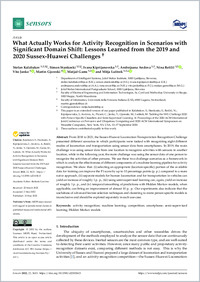What actually works for activity recognition in scenarios with significant domain shift : lessons learned from the 2019 and 2020 Sussex-Huawei challenges
- Kalabakov, Stefan Department of Intelligent Systems, Jožef Stefan Institute, Ljubljana, Slovenia - Jožef Stefan International Postgraduate School, Ljubljana, Slovenia - Faculty of Electrical Engineering and Information Technologies, Ss. Cyril and Methodius University in Skopje, Skopje, North Macedonia
- Stankoski, Simon Department of Intelligent Systems, Jožef Stefan Institute, Ljubljana, Slovenia - Jožef Stefan International Postgraduate School, Ljubljana, Slovenia
- Kiprijanovska, Ivana Department of Intelligent Systems, Jožef Stefan Institute, Ljubljana, Slovenia - Jožef Stefan International Postgraduate School, Ljubljana, Slovenia
- Andova, Andrejaana Department of Intelligent Systems, Jožef Stefan Institute, Ljubljana, Slovenia - Jožef Stefan International Postgraduate School, Ljubljana, Slovenia
- Reščič , Nina ORCID Department of Intelligent Systems, Jožef Stefan Institute, Ljubljana, Slovenia - Jožef Stefan International Postgraduate School, Ljubljana, Slovenia
- Janko, Vito ORCID Department of Intelligent Systems, Jožef Stefan Institute, Ljubljana, Slovenia
- Gjoreski, Martin ORCID Facoltà di scienze informatiche, Università della Svizzera italiana, Svizzera
- Gams, Matjaž ORCID Department of Intelligent Systems, Jožef Stefan Institute, Ljubljana, Slovenia - Jožef Stefan International Postgraduate School, Ljubljana, Slovenia
- Luštrek, Mitja ORCID Department of Intelligent Systems, Jožef Stefan Institute, Ljubljana, Slovenia - Jožef Stefan International Postgraduate School, Ljubljana, Slovenia
- 2022
Published in:
- Sensors. - 2022, vol. 22, no. 10, p. 3613
Activity recognition
Machine learning
Competition
Smartphone
Semi-supervised learning
Hidden Markov models
English
From 2018 to 2021, the Sussex-Huawei Locomotion-Transportation Recognition Challenge presented different scenarios in which participants were tasked with recognizing eight different modes of locomotion and transportation using sensor data from smartphones. In 2019, the main challenge was using sensor data from one location to recognize activities with sensors in another location, while in the following year, the main challenge was using the sensor data of one person to recognize the activities of other persons. We use these two challenge scenarios as a framework in which to analyze the effectiveness of different components of a machine-learning pipeline for activity recognition. We show that: (i) selecting an appropriate (location-specific) portion of the available data for training can improve the F1 score by up to 10 percentage points (p. p.) compared to a more naive approach, (ii) separate models for human locomotion and for transportation in vehicles can yield an increase of roughly 1 p. p., (iii) using semi-supervised learning can, again, yield an increase of roughly 1 p. p., and (iv) temporal smoothing of predictions with Hidden Markov models, when applicable, can bring an improvement of almost 10 p. p. Our experiments also indicate that the usefulness of advanced feature selection techniques and clustering to create person-specific models is inconclusive and should be explored separately in each use-case.
- Collections
- Language
-
- English
- Classification
- Computer science and technology
- License
- Open access status
- gold
- Identifiers
-
- DOI 10.3390/s22103613
- ARK ark:/12658/srd1326718
- Persistent URL
- https://n2t.net/ark:/12658/srd1326718
Statistics
Document views: 89
File downloads:
- Gjoreski_2022_MDPI_sensors: 108
